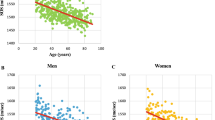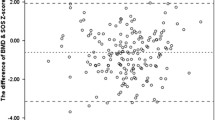Abstract
The association between quantitative ultrasound (QUS) and bone turnover in postmenopausal women of different ages is an area of continuous investigation. The aim of this study was to investigate the relationship of ultrasound parameters [broadband ultrasound attenuation (BUA) and speed of sound (SOS)] to bone mineral density (BMD) and biochemical markers of bone turnover in three age groups of postmenopausal women. One hundred and twenty-three postmenopausal Caucasian women were divided into three groups according to their age: group A, range 44–54 years, mean age (±SD) 48.3 ± 2.3; group B, range 55–65 years, mean age 59.4 ± 2.1; and group C, range 66–77 years, mean age 68.2 ± 3.1. Ultrasound parameters were measured by the DTU-one imaging ultrasonometer in the calcaneus. BMD was assessed by dual-energy X-ray absorptiometry (DEXA) at the lumbar spine, femoral neck, and trochanter. Bone turnover was assessed by serum bone-specific alkaline phosphatase (BAP), urinary excretion of free deoxypyridinoline, N-telopeptides (NTX), and C-telopeptide breakdown products of type I collagen (CTX). QUS and BMD were significantly correlated in all sites, except hip BMD in group A. The most significant correlation was observed between BUA and femoral neck BMD in group C (r = 0.626, p < 0.01). BUA correlated significantly with BAP, NTX, and CTX (r = −0.434, −0.511, −0.478, respectively; p < 0.01), and SOS with BAP and NTX (r = −0.351 and −0.356, respectively; p < 0.05) only in group C. In groups A and B, ultrasound parameters did not correlate significantly to biochemical markers. Ultrasound parameters were better correlated to hip BMD and to biochemical markers of bone turnover in elderly postmenopausal women. These ultrasound measurements could be used as a screening test for bone status, either in nonambulatory third aged women or in those living in rural areas where attending medical centers with DEXA equipment and biochemical laboratories is difficult.
Similar content being viewed by others
References
Anonymous (1993) Consensus development conference: diagnosis, prophylaxis and treatment of osteoporosis. Am J Med 94:646–650
Hans D, Dargent-Molina P, Schott AM, Sebert JL, Cormier C, Kotzki PO, Delmas PD, Pouilles JM, Breart G, Meunier PJ (1996) Ultrasonographic heel measurements to predict hip fracture in elderly women: the EPIDOS prospective study. Lancet 348:511–514
Bauer DC, Gluer CC, Cauley JA, Vogt TM, Ensrud KE, Genant HK, Black DM (1997) Broadband ultrasound attenuation predicts fractures strongly and independently of densitometry in older women: a prospective study. Study of Osteoporotic Fractures Research Group. Arch Intern Med 157:629–634
Porter RW, Miller CG, Grainger D, Palmer SB (1990) Prediction of hip fracture in elderly women: a prospective study. BMJ 301:638–641
Thompson PW, Taylor J, Oliver R, Fisher A (1998) Quantitative ultrasound (QUS) of the heel predicts wrist and osteoporosis-related fractures in women age 45–75 years. J Clin Densitom 1:219–225
Huopio J, Kroger H, Honkanen R, Jurvelin J, Saarikoski S, Alhava E (2004) Calcaneal ultrasound predicts early postmenopausal fractures as well as axial BMD. A prospective study of 422 women. Osteoporos Int 15:190–195
Stewart A, Kumar V, Reid DM (2006) Long-term fracture prediction by DXA and QUS: a 10-year prospective study. J Bone Miner Res 21:413–418
Khaw KT, Reeve J, Luben R, Bingham S, Welch A, Wareham N, Oakes S, Day N (2004) Prediction of total and hip fracture risk in men and women by quantitative ultrasound of the calcaneus: EPIC-Norfolk prospective population study. Lancet 363:197–202
Drozdzowska B, Pluskiewicz W (2005) Quantitative ultrasound in diagnosis of metabolic bone diseases. Curr Med Imag Rev 1:67–73
Faulkner KG, McClung MR, Coleman LJ, Kingston-Sandahl E (1994) Quantitative ultrasound of the heel: correlation with densitometric measurements at different skeletal sites. Osteoporos Int 4:42–47
Graafmans WC, van Lingen A, Ooms ME, Bezemer PD, Lips P (1996) Ultrasound measurements in the calcaneus: precision and its relation with bone mineral density of the heel, hip and lumbar spine. Bone 19:97–100
Yeap SS, Pearson D, Cawte SA, Hosking DJ (1998) The relationship between bone mineral density and ultrasound in postmenopausal and osteoporotic women. Osteoporos Int 8:141–146
Dretakis EC, Kontakis GM, Steriopoulos CA, Dretakis CE (1994) Decreased broadband ultrasound attenuation of the calcaneus in women with fragility fracture. Acta Orthop Scand 65:305–308
Gonnelli S, Cepollaro C, Agnusdei D, Palmieri R, Rossi S, Gennari C (1995) Diagnostic value of ultrasound analysis and bone densitometry as predictors of vertebral deformity in postmenopausal women. Osteoporos Int 5:413–418
Schott AM, Weill-Engerer S, Hans D, Duboeuf F, Delmas PD, Meunier PJ (1995) Ultrasound discriminates patients with hip fracture equally well as dual energy X-ray absorptiometry and independently of bone mineral density. J Bone Miner Res 10:243–249
Delmas PD (1995) Biochemical markers for the assessment of bone turnover. In: Riggs BL, Melton LJ III (eds) Osteoporosis: etiology, diagnosis and management, 2nd edn. Lippincott-Raven, Philadelphia, PA, pp 319–333
Garnero P, Hausherr E, Chapuy M-C, Marcelli C, Grandjean H, Muller C, Cormier C, Breart G, Meunier PJ, Delmas PD (1996) Markers of bone resorption predict hip fracture in elderly women: the EPIDOS prospective study. J Bone Miner Res 11:1531–1538
Melton LJ III, Khosla S, Atkinson EJ, O’Fallon WM, Riggs BL (1997) Relationship of bone turnover to bone density and fractures. J Bone Miner Res 12:1083–1091
Taguchi Y, Gorai I, Zhang MG, Chaki O, Nakayama M, Minaguchi H (1998) Differences in bone resorption after menopause in Japanese women with normal or low bone mineral density: quantitation of urinary cross-linked N-telopeptides. Calcif Tissue Int 62:395–399
Garnero P, Sornay-Rendu E, Chapuy M-C, Delmas PD (1996) Increased bone turnover in late postmenopausal women is a major determinant of osteoporosis. J Bone Miner Res 11:337–349
Kawana K, Kushida K, Takahashi M, Ohishi T, Denda M, Yamazaki K, Inoue T (1994) The effect of menopause on biochemical markers and ultrasound densitometry in healthy females. Calcif Tissue Int 55:420–425
Krieg MA, Cornuz J, Jacquet AF, Thiébaud D, Burckhardt P (1998) Influence of anthropometric parameters and biochemical markers of bone metabolism on quantitative ultrasound of bone in the institutionalized elderly. Osteoporos Int 8:115–120
Fiore CE, Pennisi P, Gibilaro M, DiFazzio S, Impellizzieri D, Ramirez MG (1999) Correlation of quantitative ultrasound of bone with biochemical markers of bone resorption in women with osteoporotic fractures. J Clin Densitom 2(3):231–239
Matsushita R, Yamamoto I, Takada M, Hamanaka Y, Yuh I, Morita R (2000) Comparison of various biochemical measurements with bone mineral densitometry and quantitative ultrasound for the assessment of vertebral fracture. J Bone Miner Metab 18:158–164
Hoshino H, Kushida K, Takahashi M, Yamazaki K, Denda M, Atsumi K, Oikawa M, Toyoyama O, Kawana K, Inoue T (2000) Changes in levels of biochemical markers and ultrasound indices of os calcis across the menopausal transition. Osteoporos Int 11:128–133
Baran DT, Kelly AM, Karellas A, Gionet M, Price M, Leahey D, Steuterman S, McSherry B, Roche J (1988) Ultrasound attenuation of the os calcis in women with osteoporosis and hip fractures. Calcif Tissue Int 43:138–142
Damilakis J, Perisinakis K, Vagios E, Tsinikas D, Gourtsoyiannis N (1998) Effect of region of interest location on ultrasound measurements of the calcaneus. Calcif Tissue Int 63:300–305
Schneider J, Bundschuh B, Spath C, Landkammer C, Muller H, Sommer U, Gotz M, Nawroth P, Heilmann P, Kasperk C (2004) Discrimination of patients with and without vertebral fractures as measured by ultrasound and DXA osteodensitometry. Calcif Tissue Int 74:246–254
Dubois EF, van den Bergh JP, Smals AG, van de Meerendonk CW, Zwinderman AH, Schweitzer DH (2001) Comparison of quantitative ultrasound parameters with dual energy X-ray absorptiometry in pre- and postmenopausal women. Neth J Med 58:62–70
He YQ, Fan B, Hans D, Li J, Wu CY, Njeh CF, Zhao S, Lu Y, Tsuda-Futami E, Fuerst T, Genant HK (2000) Assessment of a new quantitative ultrasound calcaneus measurement: precision and discrimination of hip fractures in elderly women compared with dual X-ray absorptiometry. Osteoporos Int 11:354–360
Diessel E, Fuerst T, Njeh CF, Hans D, Cheng S, Genant HK (2000) Comparison of an imaging heel quantitative ultrasound device (DTU-one) with densitometric and ultrasonic measurements. Br J Radiol 73(865):23–30
Chappard C, Laugier P, Fournier B, Roux C, Berger G (1997) Assessment of the relationship between broadband ultrasound attenuation and bone mineral density at the calcaneus using BUA imaging and DXA. Osteoporos Int 7:316–322
Massie A, Reid DM, Porter RW (1993) Screening for osteoporosis: comparison between dual energy X-ray absorptiometry and broadband ultrasound attenuation in 1000 perimenopausal women. Osteoporos Int 3:107–110
Jørgensen HL, Warming L, Bjarnason NH, Andersen PB, Hassager C (2001) How does quantitative ultrasound compare to dual X-ray absorptiometry at various skeletal sites in relation to the WHO diagnosis categories? Clin Physiol 21:51–59
Hans D, Arlot ME, Schott AM, Roux JP, Kotzki PD, Meunier PJ (1995) Do ultrasound measurements on the os calcis reflect more the bone microarchitecture than the bone mass? A two-dimensional histomorphometric study. Bone 16:295–300
Hans D, Wu C, Njeh CF, Zhaos S, Augat P, Newitt D, Link T, Lu Y, Majumdar S, Genant HK (1999) Ultrasound velocity of trabecular cubes reflects mainly bone density and elasticity. Calcif Tissue Int 64(1):18–23
Chaffai G, Peyrin F, Nuzzo S, Porcher R, Berger G, Laugier P (2002) Ultrasound characterization of human cancellous bone using transmission and backscatter measurements: relationships to density and microstructure. Bone 30(1):229–237
Glüer CC, Wu CY, Jergas M, Goldstein SA, Genant HK (1994) Three quantitative ultrasound parameters reflect bone structure. Calcif Tissue Int 55:46–52
Rico H, Hernandez ER, Paez E, Seco C, Gervas JJ, Villa LF (2001) Do ultrasound measurements reflect bone microarchitecture rather than bone mass? An in vitro study of the rat femur with the use of ultrasound densitometry and histomorphometry. Invest Radiol 36(6):323–326
Cortet B, Boutry N, Dubois P, Legroux-Gerot I, Cotten A, Marchandise X (2004) Does quantitative ultrasound of bone reflect more bone mineral density than bone microarchitecture? Calcif Tissue Int 74(1):60–67
Liu G, Peacock M (1998) Age-related changes in serum undercarboxylated osteocalcin and its relationships with bone density, bone quality and hip fracture. Calcif Tissue Int 62:286–289
Author information
Authors and Affiliations
Corresponding author
Rights and permissions
About this article
Cite this article
Lappa, V., Dontas, I.A., Trovas, G. et al. Quantitative ultrasound is better correlated with bone mineral density and biochemical bone markers in elderly women. Clin Rheumatol 26, 1067–1073 (2007). https://doi.org/10.1007/s10067-006-0448-2
Received:
Revised:
Accepted:
Published:
Issue Date:
DOI: https://doi.org/10.1007/s10067-006-0448-2




